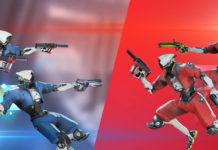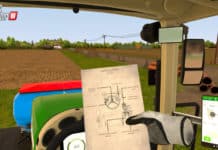Last Update on November 3, 2025
Red Matter 2 doesn’t just drop you into another sci-fi world — it transports you into a retro-futuristic Cold War dreamscape, polished to near perfection. Developed by Vertical Robot, this sequel picks up right where the original left off, thrusting players back into a universe shaped by the political tensions of an alternate timeline, where rival superpowers battle not just for Earth, but for control across the stars.
You step into the boots of Agent Sasha Riss, awakening in an abandoned lunar base with a new mission: rescue a fellow operative and uncover the secrets behind the mysterious Red Matter substance. From the very first moments, Red Matter 2 makes its intent clear — it’s not about endless action or quick thrills. It’s about slow, deliberate immersion. Every room you enter, every console you hack, and every quiet corridor you traverse feels heavy with story, history, and tension.
This isn’t just VR escapism; it’s worldbuilding you can almost touch. The result is a game that doesn’t just show you a sci-fi future — it lets you live inside one.
Visuals and Art Direction: A Retro-Futuristic Masterpiece
Visually, Red Matter 2 is nothing short of breathtaking. Whether you’re playing on a standalone Meta Quest 2, a high-end PC VR setup, or PSVR2, the game consistently pushes the hardware to its limits — and often beyond what you’d expect from current-gen VR.
Built with Unreal Engine 4, Red Matter 2 delivers meticulously detailed environments: shiny metal corridors, brutalist architecture, fogged-over control panels, and sprawling alien landscapes. The visual design is a love letter to Cold War-era futurism, blending Soviet-inspired machinery with sleek sci-fi minimalism.
On Quest 2, the technical achievement is particularly impressive. Vertical Robot uses advanced techniques like foveated rendering and texture streaming to make the game look almost “too good” for a standalone headset. On PC VR and PSVR2, everything becomes even sharper, with better lighting, reflections, and higher-resolution assets — without losing the oppressive, lonely atmosphere that defines the experience.
Gameplay: Exploration, Puzzles, and Interaction
At its core, Red Matter 2 is not about firefights or frantic action — it’s about curiosity, observation, and tactile interaction. The game invites you to explore abandoned bases, derelict stations, and strange alien facilities, piecing together clues and solving puzzles woven seamlessly into the environment.
Interaction is king here. Instead of simple button prompts, Red Matter 2 uses physics-based interactions: twisting valves, flicking switches, manipulating objects with your multifunctional tool. Everything feels tangible, enhancing immersion and making each discovery satisfying.
Puzzles vary from hacking into security terminals and rerouting power grids to decoding encrypted messages and repairing broken systems. None feel tacked-on or arbitrary; each one ties directly into the world’s logic and story.
Adding a fresh layer of movement, the game introduces a jetpack mechanic. It’s not just a gimmick — it’s a vital tool for navigation, allowing you to float across chasms, reach inaccessible platforms, and add a vertical dimension to the exploration. It expands the scale of the world, making the abandoned outposts feel even more vast and isolated.
Narrative: A Captivating and Mysterious Story
Red Matter 2 doesn’t rely on endless exposition or heavy dialogue to tell its story. Instead, it weaves its narrative into the very environment you explore, making discovery an organic part of the experience.
You continue the journey of Agent Sasha Riss, waking up to a desperate mission: rescue a missing operative and uncover the deeper secrets behind the enigmatic Red Matter. As you move through lunar outposts, abandoned space stations, and research facilities, you piece together fragments of a collapsed civilization, one shaped by political paranoia, scientific obsession, and a race for power that spiraled out of control.
Dialogues are sparse but impactful, delivered through radio communications and environmental storytelling: scattered documents, flickering monitors, scratched warnings on walls. The story unfolds slowly, rewarding players who pay attention to the small details.
Compatibility and Performance Across Headsets
One of Red Matter 2’s standout achievements is its technical flexibility across multiple VR platforms, without sacrificing its artistic vision.
On Meta Quest 2 and Quest 3, the game is a technical showcase. Thanks to advanced optimization techniques like dynamic foveated rendering and aggressive texture compression, it maintains crisp visuals and smooth performance, even on standalone hardware. It’s one of those rare Quest games that often makes you forget you’re playing without a PC.
On PC VR (via SteamVR or Oculus Link), Red Matter 2 truly shines, and is in the best games of Steam VR catalogue in 2025. With enhanced lighting, sharper textures, better reflections, and generally higher fidelity, the environments feel even richer and more oppressive. It’s the definitive experience for players with a powerful setup.
Finally, on PSVR2, Red Matter 2 benefits from next-gen upgrades: higher resolution, improved lighting effects, faster load times, and more detailed environments, thanks to the power of the PlayStation 5. Haptic feedback through the Sense controllers and headset vibrations even add a subtle new layer of immersion.
Verdict: A Must-Play VR Experience
Red Matter 2 isn’t just one of the best-looking VR games out there — it’s one of the most polished, cohesive experiences the platform has to offer. Vertical Robot doesn’t just push technical boundaries; they craft a world where exploration feels rewarding, where puzzles are meaningful, and where the atmosphere constantly keeps you on edge.
Its strengths?
Stunning visuals across every headset, tactile and satisfying gameplay mechanics, and a slow-burn narrative that rewards players who pay attention.
Its weaknesses?
Limited replayability once the story is complete, and combat sequences that, while functional, don’t quite match the brilliance of the exploration and puzzle design.
Recommended for:
- VR players who love immersive exploration and rich world-building.
- Fans of slow-paced, atmospheric sci-fi adventures.
- Anyone who wants to see how good standalone VR can truly look.
Avoid if:
- You’re looking for fast-paced action or heavy combat.
- You don’t enjoy puzzle-solving or slow narrative-driven games.











